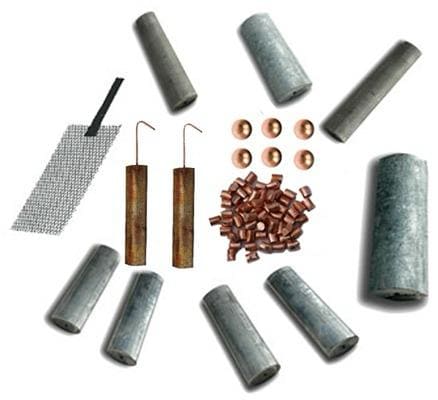Aluminum anodes and aluminum alloy anodes are lightweight, non-ferrous metal anodes with good corrosion resistance, ductility, and strength.
Brass is an alloy of copper and zinc. Brass does not resist wear as well as copper or tungsten and has a lower conductivity than copper, but is much easier to machine and can be die-cast or extruded for specialized applications.
Copper and copper alloys combine good corrosion resistance, ductility, and strength with excellent electrical and thermal conductivity.
Magnesium anodes and magnesium alloy anodes have low density, good ductility, moderate strength, and good corrosion resistance.
Titanium anodes and titanium alloy anodes are valued for their high strength-to-weight ratio.
Zinc anodes and zinc oxide anodes are used to prevent the corrosion of iron.
Anode Applications :
There are many types of metal anodes used for different applications:
Sacrificial anodes and offshore sacrificial anodes are used in cathodic protection. These metal anodes are made of a metallic element or alloy which corrodes more easily than the metal it protects. The electrons that are removed from the sacrificial anode are conducted to the protected metal, which then becomes the cathode. This cathode is protected from oxidation because reduction (rather than corrosion) occurs on the protected metal’s surface. Sacrificial anodes are used in vessels, pipelines, marine, and naval applications.
Plating anodes, as their name suggests, are used mainly in plating and electroplating applications. Typically, plating anodes and electroplating anodes are made of brass, bronze, cadmium, copper, lead, nickel, tin, or zinc. Alloys for these metal anodes include cadmium-tin, copper-tin, copper-zinc, tin-lead, tin-zinc, zinc-aluminum, zinc-magnesium, and zinc-nickel.
Mixed metal oxide (MMO) electrodes have an oxide coating over an inert metal or carbon core. The oxides consist of precious metal (Ru, Ir, Pt) oxides for catalyzing an electrolysis reaction. Titanium oxides are used for inertness, electrode corrosion protection, and lower cost. Electrochlorination is one common application. The core metals are titanium (most common), zirconium, niobium, or tantalum.
